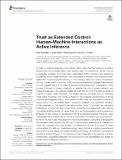Trust as Extended Control: Human-Machine Interactions as Active Inference
Author(s)
Schoeller, Felix; Miller, Mark; Salomon, Roy; Friston, Karl J.
Downloadfnsys-15-669810.pdf (1.375Mb)
Publisher with Creative Commons License
Publisher with Creative Commons License
Creative Commons Attribution
Terms of use
Metadata
Show full item recordAbstract
<jats:p>In order to interact seamlessly with robots, users must infer the causes of a robot’s behavior–and be confident about that inference (and its predictions). Hence, trust is a necessary condition for human-robot collaboration (HRC). However, and despite its crucial role, it is still largely unknown how trust emerges, develops, and supports human relationship to technological systems. In the following paper we review the literature on trust, human-robot interaction, HRC, and human interaction at large. Early models of trust suggest that it is a trade-off between benevolence and competence; while studies of human to human interaction emphasize the role of shared behavior and mutual knowledge in the gradual building of trust. We go on to introduce a model of trust as an agent’ best explanation for reliable sensory exchange with an extended motor plant or partner. This model is based on the cognitive neuroscience of active inference and suggests that, in the context of HRC, trust can be casted in terms of virtual control over an artificial agent. Interactive feedback is a necessary condition to the extension of the trustor’s perception-action cycle. This model has important implications for understanding human-robot interaction and collaboration–as it allows the traditional determinants of human trust, such as the benevolence and competence attributed to the trustee, to be defined in terms of hierarchical active inference, while vulnerability can be described in terms of information exchange and empowerment. Furthermore, this model emphasizes the role of user feedback during HRC and suggests that boredom and surprise may be used in personalized interactions as markers for under and over-reliance on the system. The description of trust as a sense of virtual control offers a crucial step toward grounding human factors in cognitive neuroscience and improving the design of human-centered technology. Furthermore, we examine the role of shared behavior in the genesis of trust, especially in the context of dyadic collaboration, suggesting important consequences for the acceptability and design of human-robot collaborative systems.</jats:p>
Date issued
2021-10-13Department
Massachusetts Institute of Technology. Media LaboratoryPublisher
Frontiers Media SA
Citation
Schoeller, Felix, Miller, Mark, Salomon, Roy and Friston, Karl J. 2021. "Trust as Extended Control: Human-Machine Interactions as Active Inference." 15.
Version: Final published version
ISSN
1662-5137